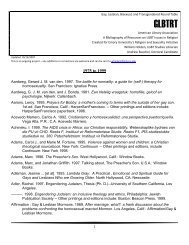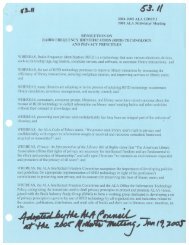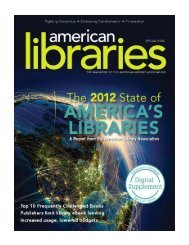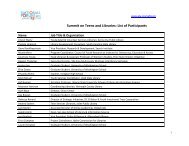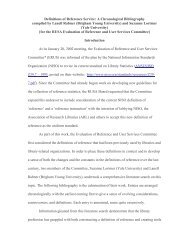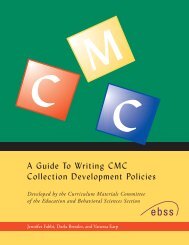The Campaign for America's Libraries - American Library Association
The Campaign for America's Libraries - American Library Association
The Campaign for America's Libraries - American Library Association
You also want an ePaper? Increase the reach of your titles
YUMPU automatically turns print PDFs into web optimized ePapers that Google loves.
Parents<br />
Alumni<br />
Prospective librarians<br />
Media<br />
7. Strategies: How will you deliver the message?<br />
Vehicles and tactics <strong>for</strong> delivering the message. Examples include:<br />
Word of mouth<br />
Banners/Posters/Displays<br />
Handouts/Giveaways, e.g., bookmarks,<br />
mugs<br />
Media: Campus and community newspapers, radio, and TV<br />
Print materials: annual report, newsletter,<br />
flyers, tent cards<br />
Web sites<br />
E-mail lists<br />
Presentations to groups<br />
Collaboration with other departments/organizations<br />
8. Evaluation measures: How will you know you succeeded?<br />
Your objectives should provide a clear means of evaluation. Frequently used measures include:<br />
circulation, Web site visits, library visits, reference statistics, attendance at programs and university<br />
events, number of media stories placed/speeches given, follow-up surveys/interviews, word-of-mouth<br />
feedback, letters of appreciation/honors received.<br />
Marketing That Can Be Seen, Heard, and Felt by All<br />
When developing a marketing plan <strong>for</strong> your library, be sure to address individuals with disabilities. Susan<br />
Gilbert Beck, president of Emanda, Inc., and consultant on library access, offers the following guidelines<br />
<strong>for</strong> ensuring your ef<strong>for</strong>ts are both legal and effective.<br />
For in<strong>for</strong>mation about federal laws and resources to assist you, see the U.S. Department of Justice<br />
Web page on disabilities at http://www.usdoj.gov/crt/ada/adahom1.htm<br />
In developing signage, publications, and other materials, be sensitive in your use of language. <strong>The</strong><br />
disability is just one facet of the person. He or she is far from being totally described by the disability.<br />
Assess the library’s traffic patterns and use of space:<br />
if outside paths and inside aisles are not wide enough to accommodate wheel chairs, make a<br />
change <strong>for</strong> better accessibility;<br />
if ramps are needed, install them;<br />
offer maps and signage to guide those who need elevators and other accommodations. See<br />
http://www.gag.org/resources/das.php<br />
make room at desks and tables <strong>for</strong> adequate access by those in wheel chairs.<br />
Assess the accessibility of the library’s Web pages<br />
at http://webxact.watchfire.com/ and follow guidelines to:<br />
allow access by Web page readers and screen readers like JAWS;<br />
allow translation of print copies by, <strong>for</strong> example, Kurzweil readers or Braille embossers and<br />
readers;<br />
create alternate pages to provide easy-to-access text describing graphics;<br />
20



